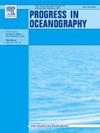Modelling the complete life cycle of an arctic copepod reveals complex trade-offs between concurrent life cycle strategies
IF 3.8
3区 地球科学
Q1 OCEANOGRAPHY
引用次数: 0
Abstract
Calanus hyperboreus is a large-bodied, biomass dominant species that performs a crucial ecosystem energy transfer by converting the spring phytoplankton bloom into lipid reserves that fuel the higher trophic levels of the Gulf of St. Lawrence (GSL) pelagic ecosystem, including the critically endangered North Atlantic right whale (Eubalena glacialis). Given that the GSL, the southernmost core habitat of C. hyperboreus, is undergoing rapid warming, developing a population model allows us to synthesize existing knowledge of the species, and to examine the species response to environmental conditions. To simulate the multi-year life cycle in the northwest GSL, model equations are implemented for ingestion, assimilation, respiration, egg production, stage development, mortality, and vertical migration behaviors including dormancy entry and exit. The 1-D particle-based model predicts the evolution of individual stage, structural mass, lipid, age, sex, abundance, and egg production, as well as the seasonal evolution of the population structure in the northwest GSL. Individual lipid-based thresholds inform the timing of ontogenetic vertical migration. Life cycle targets defined from a literature review are used to guide model parameterization and assess its performance. The simulated population structure, phenology, and size at stage are generally consistent with observations. Under 10 years of repeat year forcing, the model simulates a quasi-stable overwintering population composed of late stages CIV, CV and CVI. Observations suggest that stage CIV is the first overwintering stage in the GSL, and point to the occurrence of iteroparous females. Using the model, the relative success of diverse dormancy and reproductive phenotypes are explored. Second reproduction females reproduce earlier in winter than first reproduction females, with implications for the ability of the new generation to match the spring bloom and accumulate sufficient lipid to overwinter as stage CIV. Without iteroparity, the time window of reproduction contracts and the population is reduced, underscoring the role of a flexible multi-year life cycle in population success.
北极桡足类完整生命周期模型揭示了并行生命周期策略之间复杂的权衡关系
海牛(Calanus hyperboreus)是一种体型较大、生物量占优势的物种,它通过将春季浮游植物藻华转化为脂质储备,为圣劳伦斯湾(GSL)浮游生态系统的较高营养级(包括极度濒危的北大西洋露脊鲸(Eubalena glacialis))提供燃料,从而完成至关重要的生态系统能量转移。鉴于圣劳伦斯湾是露脊鲸(C. hyperboreus)最南端的核心栖息地,目前正在迅速变暖,建立一个种群模型使我们能够综合现有的关于该物种的知识,并研究该物种对环境条件的反应。为了模拟西北大洋洲的多年生命周期,我们对摄食、同化、呼吸、产卵、阶段发育、死亡率和垂直迁移行为(包括休眠的进入和退出)实施了模型方程。基于一维颗粒的模型可预测个体阶段、结构质量、脂质、年龄、性别、丰度和产卵量的演变,以及西北大洋洲种群结构的季节性演变。基于个体脂质的阈值为本体垂直迁移的时间提供了信息。根据文献综述确定的生命周期目标用于指导模型参数化和评估其性能。模拟的种群结构、物候和阶段大小与观测结果基本一致。在 10 年的重复年强迫条件下,模型模拟的越冬种群由 CIV、CV 和 CVI 三个晚期阶段组成。观测结果表明,CIV期是全球南极鱼类的第一个越冬期,并表明存在雌雄异体现象。利用该模型探讨了不同休眠和生殖表型的相对成功率。第二次繁殖的雌性在冬季的繁殖时间早于第一次繁殖的雌性,这对新一代能否赶上春季开花并积累足够的脂质以CIV阶段越冬有影响。如果没有迭代,繁殖的时间窗口就会收缩,种群数量就会减少,这突出了灵活的多年生命周期在种群成功中的作用。
本文章由计算机程序翻译,如有差异,请以英文原文为准。
求助全文
约1分钟内获得全文
求助全文
来源期刊

Progress in Oceanography
地学-海洋学
CiteScore
7.20
自引率
4.90%
发文量
138
审稿时长
3 months
期刊介绍:
Progress in Oceanography publishes the longer, more comprehensive papers that most oceanographers feel are necessary, on occasion, to do justice to their work. Contributions are generally either a review of an aspect of oceanography or a treatise on an expanding oceanographic subject. The articles cover the entire spectrum of disciplines within the science of oceanography. Occasionally volumes are devoted to collections of papers and conference proceedings of exceptional interest. Essential reading for all oceanographers.
 求助内容:
求助内容: 应助结果提醒方式:
应助结果提醒方式:


